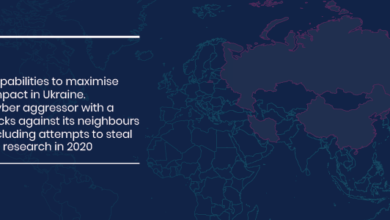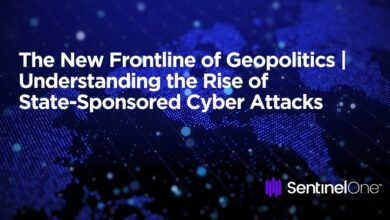
China to Strongly Retaliate US Cyber Attacks
China to strongly retaliate US cyber attacks – that’s the headline grabbing everyone’s attention. The escalating tensions between the US and China are reaching a new, dangerous level, moving beyond trade wars and into the digital realm. We’re talking potential large-scale cyberattacks targeting critical US infrastructure, from power grids to financial systems. The stakes are incredibly high, and the consequences could be devastating, impacting everything from our daily lives to the global economy.
This post dives into the potential targets, methods, geopolitical implications, and the US’s possible responses to this looming threat.
This isn’t just another geopolitical spat; it’s a potential digital Pearl Harbor. Imagine widespread power outages, crippling financial markets, and the chaos that would ensue. Understanding the potential scenarios, the vulnerabilities of our systems, and the possible retaliatory strategies is crucial. Let’s explore the intricate dance of cyber warfare and what a potential Chinese response might look like.
Potential Targets of Chinese Retaliation
The escalating cyber tensions between the US and China raise serious concerns about potential retaliatory actions. While neither nation publicly admits to initiating attacks, the possibility of a significant Chinese cyber offensive against US infrastructure remains a credible threat. Understanding the vulnerabilities of key sectors is crucial for mitigating potential damage.
A large-scale cyberattack from China targeting critical US infrastructure could have devastating consequences, ranging from widespread economic disruption to significant loss of life. The interconnected nature of these systems means that an attack on one sector could trigger cascading failures across others. The severity of the impact would depend on the scale and sophistication of the attack, as well as the preparedness of the targeted systems.
Vulnerable US Infrastructure Sectors
The US possesses a vast and complex infrastructure network, leaving several sectors highly susceptible to cyberattacks. These vulnerabilities stem from a combination of outdated technology, insufficient cybersecurity measures, and the sheer size and complexity of the systems involved. Targeting these sectors could inflict maximum damage and cripple essential services.
Several key sectors stand out as prime targets: the energy sector (power grids, pipelines), the financial sector (banking, stock markets), the transportation sector (air traffic control, railways), and the healthcare sector (hospitals, medical devices). Each sector presents unique vulnerabilities and potential consequences.
Hypothetical Scenario: Attack on the US Power Grid
Imagine a coordinated cyberattack targeting the US power grid, a critical infrastructure component upon which nearly all other sectors depend. Chinese state-sponsored hackers, leveraging advanced persistent threats (APTs), could infiltrate the control systems of multiple power generation facilities and substations across several states. The attackers could initially conduct reconnaissance, mapping the network and identifying vulnerabilities. Then, a carefully orchestrated series of attacks could disrupt power generation and distribution, causing widespread blackouts across major cities and impacting essential services like hospitals, water treatment plants, and communication networks.
The economic cost would be astronomical, with widespread business disruptions and potential loss of life due to lack of access to essential services. This scenario, while hypothetical, reflects the realistic potential for significant damage from a sophisticated cyberattack.
Comparative Analysis of Sector Vulnerabilities
Comparing the vulnerabilities of different US critical infrastructure sectors reveals varying levels of risk. The energy sector, due to its reliance on aging infrastructure and interconnected systems, is arguably the most vulnerable. A successful attack could have cascading effects, disrupting other sectors. The financial sector, with its reliance on digital transactions and interconnected networks, is also highly vulnerable to disruption.
A large-scale attack could trigger financial instability and widespread economic chaos. The healthcare sector’s reliance on digital medical records and connected devices makes it vulnerable to data breaches and disruption of essential services. Transportation systems, especially air traffic control, are vulnerable to disruptions that could ground flights and cause significant economic and logistical challenges. While each sector presents unique challenges, the interconnected nature of the US infrastructure means that an attack on one sector can have ripple effects throughout the entire system.
Methods of Chinese Cyber Retaliation: China To Strongly Retaliate Us Cyber Attacks
China’s potential for cyber retaliation against the US is a significant concern, fueled by escalating tensions and a history of state-sponsored cyber operations. Understanding the methods China might employ is crucial for anticipating and mitigating the potential impact of such actions. This involves examining the range of cyberattack techniques at their disposal, analyzing past operations, and considering the potential role of advanced persistent threats.
Types of Cyberattacks
China possesses a diverse arsenal of cyberattack techniques. These range from relatively simple, albeit disruptive, methods to highly sophisticated and targeted attacks. The choice of technique would likely depend on the specific objectives of the retaliation and the desired level of impact. Common methods include Distributed Denial-of-Service (DDoS) attacks, the deployment of malware, and sophisticated data breaches.
Examples of Past Chinese Cyber Operations
Several past cyber operations have been attributed to Chinese state-sponsored actors, offering insights into their capabilities and tactics. For instance, the 2015 attack on the US Office of Personnel Management (OPM) resulted in the theft of sensitive personal data of millions of federal employees. This demonstrated China’s capacity to conduct large-scale data breaches targeting critical infrastructure. Another example is the persistent targeting of US companies in various sectors, aiming to steal intellectual property and trade secrets.
The effectiveness of these operations has varied, with some achieving significant objectives and others being thwarted by defensive measures. The OPM breach, for example, was highly effective, while others have resulted in less significant data acquisition due to improved security protocols.
Comparison of Cyberattack Methods
| Method | Sophistication | Potential Impact | Examples |
|---|---|---|---|
| DDoS | Low to Medium | Disruption of services | Website outages, network disruptions |
| Malware | Medium to High | Data theft, system compromise | Stuxnet (though not directly attributed to China, it exemplifies the potential), ransomware attacks |
| Data Breaches | Medium to High | Data theft, reputational damage | OPM breach, targeting of private companies |
| Advanced Persistent Threats (APTs) | High | Long-term espionage, data exfiltration | Sustained infiltration of government and corporate networks |
Advanced Persistent Threats (APTs) in Retaliation
APTs represent a particularly dangerous aspect of potential Chinese cyber retaliation. These are long-term, stealthy cyber operations designed to gain persistent access to a target’s systems. APTs often involve the use of sophisticated malware, social engineering techniques, and zero-day exploits to maintain a presence undetected for extended periods. The goal is typically espionage, data exfiltration, or the establishment of a foothold for future attacks.
The prolonged nature of APTs makes them difficult to detect and eliminate, potentially causing significant long-term damage and compromising sensitive information. A successful APT campaign could provide China with valuable intelligence, technological secrets, or the ability to disrupt critical infrastructure at a later date. The potential for long-term damage and the difficulty of detection and remediation make APTs a particularly potent weapon in a cyber conflict.
Geopolitical Implications of Retaliation

A Chinese cyber retaliation against the US, even if proportionate, would dramatically escalate existing geopolitical tensions. The already fraught relationship, characterized by trade wars, disputes over Taiwan, and ideological clashes, would likely see a significant deterioration, potentially impacting global stability and international cooperation. The scale and nature of the response would determine the severity of the consequences.The international response would be multifaceted and depend heavily on the specific targets and methods of the Chinese retaliation.
Allies of the US, particularly those within NATO and the Five Eyes intelligence alliance, might express strong condemnation and potentially offer support to the US, perhaps through intelligence sharing or joint cybersecurity initiatives. However, some countries might adopt a more neutral stance, prioritizing their own national interests, especially those with significant economic ties to China. Adversaries of the US, on the other hand, might view the retaliation as a strategic victory for China, potentially emboldening them to pursue similar actions.
International organizations like the United Nations might attempt to mediate the conflict, but their effectiveness would depend on the willingness of both sides to engage in diplomatic solutions.
International Response Scenarios
The international community’s response would hinge on several factors. A targeted attack focusing on specific US government agencies might draw a more contained response than a widespread attack affecting critical infrastructure or private sector entities. A targeted response, limited to cyber countermeasures, would likely generate less global alarm than an escalation involving kinetic military action or economic sanctions.
For example, a scenario involving a significant disruption to US financial systems could trigger international condemnation and coordinated efforts to mitigate the damage, possibly involving sanctions against Chinese entities. Conversely, a less impactful attack might result in limited international involvement beyond statements of concern.
Potential Timeline of Consequences
The immediate aftermath of a Chinese cyber retaliation could see a rapid escalation of rhetoric, with both countries issuing strong statements and accusations. This would be followed by a period of intense cyber activity, as both sides probe each other’s defenses and potentially launch further attacks. Depending on the severity of the initial attack and the nature of the retaliation, this could last from weeks to months.
Economic repercussions could follow, impacting trade relations and investment flows. A prolonged conflict could lead to further diplomatic isolation of China, strengthening existing alliances against it. In a worst-case scenario, the escalation could extend beyond the cyber realm, potentially involving military actions or wider conflicts. For instance, consider the 2007 Estonian cyberattacks, which, while not resulting in military conflict, significantly heightened tensions and spurred international discussion on cybersecurity.
A Chinese response of similar magnitude could lead to parallel consequences, potentially even more severe due to the greater geopolitical weight of the actors involved.
Relevant International Treaties and Agreements, China to strongly retaliate us cyber attacks
Several international treaties and agreements could be relevant to this scenario, though their applicability might be debated. The Budapest Convention on Cybercrime, while widely ratified, lacks a robust enforcement mechanism. The UN Charter, which emphasizes peaceful resolution of disputes, could provide a framework for international mediation. However, the lack of a universally accepted definition of cyber warfare and the difficulties in attributing attacks make the application of international law challenging.
The lack of binding international norms on cyber warfare highlights the need for stronger international cooperation and the development of clearer legal frameworks to address future cyber conflicts. The situation mirrors the challenges faced by the international community in addressing other forms of asymmetric warfare.
US Response Strategies
A sophisticated cyberattack from China would necessitate a multi-pronged US response, encompassing robust defensive measures, assertive countermeasures, and proactive steps to bolster overall cybersecurity. The gravity of such an attack demands a strategic approach that balances immediate mitigation with long-term deterrence and resilience. Failing to adequately respond could embolden further aggression and undermine US national security interests.The US possesses a significant arsenal of cyber capabilities, but effectively deploying them requires careful consideration of potential escalation and unintended consequences.
A measured yet firm response is crucial to deter future attacks while avoiding a full-blown cyber war. Past experiences offer valuable lessons on how to navigate this complex landscape.
Defensive Measures to Mitigate Cyberattack Impact
Effective defense against a large-scale cyberattack from China requires a layered approach. This includes strengthening critical infrastructure defenses with advanced intrusion detection systems, regularly patching vulnerabilities in software and hardware, and implementing robust data backups and recovery plans. Employing multi-factor authentication, rigorous access control measures, and employee cybersecurity training are equally vital. Furthermore, enhancing threat intelligence gathering capabilities to identify and preempt potential attacks is crucial.
Investing in advanced cybersecurity technologies, such as artificial intelligence and machine learning for threat detection and response, is also paramount. The private sector plays a vital role here, and robust public-private partnerships are essential for sharing threat information and coordinating defensive efforts.
China’s vow to strongly retaliate against US cyberattacks has me thinking about the need for robust, secure systems. Developing those systems efficiently is key, and that’s where learning about the advancements in domino app dev, the low-code and pro-code future , becomes crucial. Understanding these development approaches could be vital in mitigating future threats and bolstering defenses against increasingly sophisticated attacks from China.
Leveraging US Cyber Capabilities for Deterrence and Response
The US possesses considerable offensive cyber capabilities that can be used for deterrence and measured retaliation. These capabilities include the ability to disrupt malicious cyber activity, identify and attribute attacks to their perpetrators, and potentially launch counter-attacks against critical Chinese infrastructure if deemed necessary. However, any such actions must be carefully calibrated to avoid escalating the conflict unnecessarily.
Attribution is a key element; demonstrating conclusively that China was responsible for an attack is crucial for justifying a response. This requires meticulous forensic analysis and a strong intelligence network. The goal should be to impose costs on the attackers, making future attacks less appealing, rather than initiating a full-scale cyber war.
Examples of Past US Responses to Cyberattacks
While the US government rarely publicly acknowledges specific cyber operations, there are instances of retaliatory actions attributed (though not always officially confirmed) to US responses to cyberattacks from other nations. For example, the Stuxnet worm, though a joint US-Israeli operation, demonstrated the potential for sophisticated cyberattacks to cripple critical infrastructure, specifically targeting Iranian nuclear facilities. While not directly a response to a specific attack, it serves as an example of the potential for targeted and disruptive cyber operations.
Other instances, though less publicized, likely involved the disruption of malicious cyber activities, attribution campaigns, and diplomatic pressure. The US response to cyberattacks varies depending on the severity, attribution certainty, and the broader geopolitical context.
Proactive Steps to Improve Cybersecurity
A proactive approach is essential to prevent and mitigate future cyberattacks. This requires a concerted effort from both the government and the private sector.
China’s vow to strongly retaliate against US cyberattacks highlights the urgent need for robust cybersecurity measures. This makes understanding solutions like those offered by Bitglass crucial, especially with the rise of cloud security posture management, as detailed in this insightful article on bitglass and the rise of cloud security posture management. Given the escalating tensions, proactive security strategies, including comprehensive cloud security, are no longer optional but essential for mitigating potential damage from retaliatory cyberattacks.
- Mandatory Cybersecurity Standards for Critical Infrastructure: Enacting and enforcing stricter cybersecurity standards for critical infrastructure sectors (energy, finance, healthcare) is crucial. This includes mandatory vulnerability disclosure and patching protocols.
- Increased Investment in Cybersecurity Research and Development: Significant investment is needed in developing and deploying advanced cybersecurity technologies, including AI-driven threat detection and response systems.
- Improved Information Sharing and Collaboration: Strengthening public-private partnerships to facilitate the seamless sharing of threat intelligence and best practices is vital.
- Strengthening International Cooperation: Working with allies to establish norms of responsible state behavior in cyberspace and to develop mechanisms for addressing cyberattacks collaboratively.
- Cybersecurity Education and Training: Investing in cybersecurity education and training programs for both the public and private sectors is critical to building a more resilient cybersecurity workforce.
Economic Ramifications
A large-scale cyberattack against the United States could trigger a cascade of economic consequences, far exceeding the immediate costs of system repairs and data recovery. The interconnected nature of the modern global economy means that disruption in one sector rapidly ripples outwards, affecting numerous others and potentially leading to a significant downturn. Understanding the potential economic damage is crucial for developing effective cybersecurity strategies and mitigating future risks.The economic consequences for both the US and China in a retaliatory cyber campaign would be asymmetrical, though both would experience negative impacts.
The US, with its larger and more globally integrated economy, would likely suffer more extensive immediate damage. However, China’s dependence on international trade and investment could also lead to significant long-term economic repercussions if the retaliatory campaign escalates or triggers further instability. The severity of the economic fallout depends heavily on the targets of the attacks, their duration, and the effectiveness of the response mechanisms.
Potential Economic Damage to the US
A successful cyberattack targeting critical infrastructure, such as the power grid or financial institutions, could cause widespread disruption and significant economic losses. Consider the 2003 Northeast blackout, which cost billions of dollars in lost productivity and damage. A sophisticated cyberattack could easily dwarf that event in scale and severity. The impact would extend beyond direct economic losses to include decreased consumer confidence, reduced investment, and a potential decline in the nation’s credit rating.
The resulting uncertainty could further hinder economic growth for an extended period. For instance, a sustained disruption to the financial sector could freeze credit markets, making it difficult for businesses to obtain loans and hindering economic activity. Similarly, a crippling attack on the energy sector could lead to widespread power outages, disrupting manufacturing, transportation, and other essential services.
Impact on Specific Industries
The financial sector would be a prime target due to its interconnectedness and reliance on digital systems. A successful attack could compromise sensitive financial data, disrupt trading platforms, and lead to significant financial losses for individuals and institutions alike. The energy sector, another critical infrastructure component, would be vulnerable to similar attacks, potentially leading to power outages, supply chain disruptions, and price volatility.
The healthcare industry, increasingly reliant on digital medical records and connected devices, would face disruptions to patient care and data breaches, leading to significant costs associated with recovery and legal liabilities. The manufacturing sector, with its extensive use of automation and supply chain management systems, would also be vulnerable to disruptions, potentially leading to production delays and economic losses.
Hypothetical Model of Ripple Effects
Imagine a scenario where a sophisticated cyberattack targets major US banks. The immediate impact would be the disruption of financial transactions, causing panic in the markets and leading to a sharp decline in stock prices. This would trigger a chain reaction, affecting businesses dependent on credit lines, leading to layoffs and reduced consumer spending. The decreased consumer confidence would further reduce economic activity, leading to a contraction in GDP.
Simultaneously, the attack would disrupt the supply chain, as businesses struggle to obtain financing and manage their inventories. This would lead to shortages of goods and services, further fueling inflation and impacting the broader economy. This cascading effect would amplify the initial impact of the cyberattack, potentially leading to a prolonged economic downturn.
Public Perception and Media Coverage
A Chinese cyberattack on the US would be a major geopolitical event, instantly dominating news cycles globally. The media’s portrayal would significantly influence public opinion, potentially impacting trust in government and shaping national security policy. The narrative crafted by news outlets, social media, and political commentators would be crucial in determining the public’s response and the government’s ability to manage the crisis.The potential impact of media coverage on public trust and confidence in government institutions is substantial.
Depending on the perceived response and transparency of the government, public confidence could either soar or plummet. A swift, decisive, and transparent response would likely bolster public trust, while a slow, opaque, or overly aggressive reaction could erode it. Furthermore, the media’s framing of the event – focusing on damage inflicted versus the government’s countermeasures – would significantly shape public perception.
A focus on extensive damage without highlighting effective countermeasures would likely increase anxiety and distrust.
Hypothetical News Report: Chinese Cyberattack on US Infrastructure
A coordinated cyberattack, attributed to Chinese state-sponsored actors, crippled major segments of the US power grid in several states late Tuesday night. Initial reports indicate widespread blackouts affecting millions, impacting essential services like hospitals, transportation, and communication networks. The White House released a statement confirming the attack and vowing a strong response. The statement emphasized the government’s commitment to identifying the perpetrators and holding them accountable, while reassuring the public that efforts are underway to restore power and critical infrastructure.
Experts are analyzing the attack’s scope and assessing the long-term damage. Security analysts are warning of potential follow-up attacks, urging citizens to remain vigilant and follow official guidance. The stock market experienced a significant drop in early trading, reflecting investor concerns about the economic implications of the widespread disruption. This attack follows a series of escalating cyber skirmishes between the US and China, heightening tensions between the two superpowers.
The incident is likely to trigger a new round of sanctions and retaliatory measures, further escalating the already strained geopolitical relationship.
Potential for Misinformation and Disinformation Campaigns
The aftermath of a significant cyberattack would be fertile ground for the spread of misinformation and disinformation. State-sponsored actors, both from China and other nations, could leverage the chaos to spread false narratives, sow discord, and undermine public trust. Social media platforms would likely become battlegrounds for competing narratives, making it challenging for the public to discern truth from falsehood.
For example, fabricated evidence of US government culpability could be spread online, while genuine information about the attack’s impact could be deliberately downplayed or distorted. The government would need to deploy sophisticated counter-disinformation strategies, including proactive public communication campaigns and close collaboration with social media platforms, to mitigate the impact of such efforts. Past examples, such as the spread of misinformation during the COVID-19 pandemic, demonstrate the ease with which false narratives can gain traction and the difficulty in countering them effectively.
Final Review

The possibility of China retaliating against the US with significant cyberattacks is a serious threat with far-reaching consequences. The potential for widespread disruption, economic damage, and escalating geopolitical tensions is undeniable. While the US has its own cyber capabilities, the best defense is a strong offense, coupled with proactive measures to bolster our cybersecurity infrastructure. The coming years will likely see a further escalation of cyber warfare, making it more important than ever to understand the risks and prepare accordingly.
This isn’t a game; it’s a fight for control in the digital age, and the stakes are higher than ever before.
FAQ Resource
What types of malware might China use in a cyberattack?
China could employ a range of malware, from sophisticated APTs designed for long-term espionage and data exfiltration to more destructive malware aimed at crippling systems.
How would the international community respond to a major Chinese cyberattack on the US?
The international response would likely be complex and divided. Some nations might condemn China, while others might remain neutral or even tacitly supportive. International treaties and agreements regarding cyber warfare would be invoked, but their effectiveness is uncertain.
What role could misinformation play in a cyberattack scenario?
Misinformation and disinformation campaigns could be used to sow confusion, deflect blame, and undermine public trust in government and institutions during and after an attack.
Could a cyberattack trigger a wider military conflict?
While unlikely, the possibility of a cyberattack escalating into a wider military conflict exists. The response of both governments and the public will be crucial in determining whether the situation remains contained.





